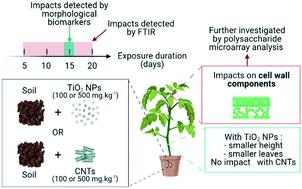当前位置:
X-MOL 学术
›
Environ. Sci.: Nano
›
论文详情
Our official English website, www.x-mol.net, welcomes your
feedback! (Note: you will need to create a separate account there.)
Fourier transform infrared spectroscopy contribution to disentangle nanomaterial (DWCNT, TiO2) impacts on tomato plants
Environmental Science: Nano ( IF 5.8 ) Pub Date : 2021-08-23 , DOI: 10.1039/d1en00455g Clarisse Liné 1, 2 , Juan Reyes-Herrera 3 , Mansi Bakshi 1, 4 , Mohammad Wazne 3 , Valentin Costa 1 , David Roujol 5 , Elisabeth Jamet 5 , Hiram Castillo-Michel 3 , Emmanuel Flahaut 2 , Camille Larue 1
Environmental Science: Nano ( IF 5.8 ) Pub Date : 2021-08-23 , DOI: 10.1039/d1en00455g Clarisse Liné 1, 2 , Juan Reyes-Herrera 3 , Mansi Bakshi 1, 4 , Mohammad Wazne 3 , Valentin Costa 1 , David Roujol 5 , Elisabeth Jamet 5 , Hiram Castillo-Michel 3 , Emmanuel Flahaut 2 , Camille Larue 1
Affiliation

|
Carbon nanotubes (CNTs) and titanium dioxide nanoparticles (TiO2-NPs) are among the most used nanomaterials (NMs). However, their impacts especially on the terrestrial ecosystems and on plants are still controversial. Apart from obvious physico-chemical differences, a possible explanation of these contrasting results could be the wide range of methods used to evaluate the toxicity at different levels of plant physiology. Fourier transformed infrared (FTIR) spectroscopy is a sensitive and widely informative technique that probes the chemical composition of plants. In this study, we investigated the impacts of CNTs and TiO2-NPs (100 and 500 mg kg−1) on tomato plants after 5, 10, 15 and 20 days of exposure in soil. Using morphological parameters, no toxicity was found except after 15 days of exposure (−57% in height and −62% in foliar area for plants exposed to 100 mg kg−1 TiO2-NPs, but no impact after CNT exposure) while FTIR revealed effects of the two NMs starting after 5 days of exposure and being maximum after 15 days. After spectral data treatment optimization, FTIR results suggested modifications in leaf cell wall components of plants subjected to both NMs. Microarray polymer profiling confirmed changes in xyloglucan and homogalacturonan levels for plants exposed to TiO2-NPs. In summary, FTIR was an effective screening method to evaluate the impacts of NMs on tomato plants and to identify their implications on the plant cell walls.
中文翻译:

傅里叶变换红外光谱对解开纳米材料(DWCNT、TiO2)对番茄植株影响的贡献
碳纳米管 (CNT) 和二氧化钛纳米粒子 (TiO 2 -NP) 是最常用的纳米材料 (NM)。然而,它们对陆地生态系统和植物的影响仍然存在争议。除了明显的物理化学差异外,这些对比结果的一个可能解释可能是用于评估不同植物生理水平的毒性的方法范围广泛。傅里叶变换红外 (FTIR) 光谱是一种灵敏且信息量广泛的技术,可探测植物的化学成分。在这项研究中,我们研究了 CNTs 和 TiO 2 -NPs(100 和 500 mg kg -1) 在土壤中暴露 5、10、15 和 20 天后的番茄植株上。使用形态学参数,除了暴露 15 天后(暴露于 100 mg kg -1 TiO 2 -NPs 的植物高度为 -57% 和叶面积为 -62% ,但在 CNT 暴露后没有影响)外,未发现毒性,而 FTIR揭示了两种 NM 在暴露 5 天后开始的影响,并在 15 天后达到最大。光谱数据处理优化后,FTIR 结果表明,经过这两种 NMs 处理的植物的叶细胞壁成分发生了变化。微阵列聚合物分析证实了暴露于 TiO 2 的植物的木葡聚糖和同型半乳糖醛酸水平的变化-NP。总之,FTIR 是一种有效的筛选方法,可以评估 NMs 对番茄植物的影响,并确定它们对植物细胞壁的影响。
更新日期:2021-08-26
中文翻译:

傅里叶变换红外光谱对解开纳米材料(DWCNT、TiO2)对番茄植株影响的贡献
碳纳米管 (CNT) 和二氧化钛纳米粒子 (TiO 2 -NP) 是最常用的纳米材料 (NM)。然而,它们对陆地生态系统和植物的影响仍然存在争议。除了明显的物理化学差异外,这些对比结果的一个可能解释可能是用于评估不同植物生理水平的毒性的方法范围广泛。傅里叶变换红外 (FTIR) 光谱是一种灵敏且信息量广泛的技术,可探测植物的化学成分。在这项研究中,我们研究了 CNTs 和 TiO 2 -NPs(100 和 500 mg kg -1) 在土壤中暴露 5、10、15 和 20 天后的番茄植株上。使用形态学参数,除了暴露 15 天后(暴露于 100 mg kg -1 TiO 2 -NPs 的植物高度为 -57% 和叶面积为 -62% ,但在 CNT 暴露后没有影响)外,未发现毒性,而 FTIR揭示了两种 NM 在暴露 5 天后开始的影响,并在 15 天后达到最大。光谱数据处理优化后,FTIR 结果表明,经过这两种 NMs 处理的植物的叶细胞壁成分发生了变化。微阵列聚合物分析证实了暴露于 TiO 2 的植物的木葡聚糖和同型半乳糖醛酸水平的变化-NP。总之,FTIR 是一种有效的筛选方法,可以评估 NMs 对番茄植物的影响,并确定它们对植物细胞壁的影响。











































 京公网安备 11010802027423号
京公网安备 11010802027423号